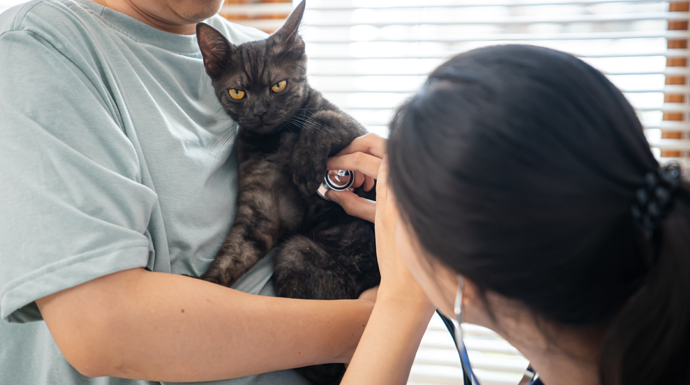Low and middle-income families may have a new way to manage the
cost of veterinary care
With Congress considering the People and Animals Well-being (PAW) Act, veterinary clinics may soon see changes in how some clients pay for pet care. This federal bill
would allow health savings accounts (HSAs) and flexible spending accounts (FSAs) to cover pet care costs, potentially reducing financial barriers for pet owners. As more clients gain access to affordable care options, this could influence clinic operations, patient outcomes, and even the pet insurance landscape. Here’s what your clinic
needs to know.

What does it mean for families (and vets)?
The PAW Act is designed to ease financial stress for pet owners by allowing them to use pre-tax funds from health savings accounts (HSAs) and flexible spending accounts (FSAs) to pay for pet care. This could significantly impact veterinary clinics.

More families can afford care
Of the roughly 87 million households in the U.S. with pets (Forbes), 43% have been unable to front the bill for their pets needs at one point in time (The Humane Society).
Families can afford more of what their pets need.
In 2023, U.S. pet owners spent $38.3 billion on vet care. If more owners can use HSAs/FSAs, clinics will see more frequent visits.
Fewer families will delay vet visits.
30% of pet owners delayed vet visits due to costs. The PAW Act could remove these barriers and improve overall patient care.

How will it work?
When the bill passes, it will work much like any other medical expenses.
For pet owners:

Check account eligibility
Pet owners would need to ensure they have either an HSA or FSA with available funds.
Submit veterinary expenses
After a veterinary visit, clients can submit their vet bill as an eligible expense under their HSA or FSA, just as they would for human medical expenses.
Reimbursement
For FSAs, pet owners could pay for the service upfront and get reimbursed. For HSAs, they may be able to pay directly using their
HSA debit card if the vet clinic accepts it.
For vet clinics:

Determine accepted payments
Clinics would need to confirm whether they accept HSA debit cards
or if they will handle FSA reimbursements.
Provide receipts
Clinics must provide itemized receipts detailing services, similar to
how they currently handle pet insurance claims. These receipts are necessary for the client to submit to their HSA or FSA provider.
Patient interaction
Explain the process to clients, particularly how the PAW Act allows
them to use pre-tax dollars for their pet’s healthcare, encouraging
them to take advantage of this option.
You can grow your clinic by helping families understand this new opportunity
When veterinary care becomes more affordable, clients are less likely to delay routine checkups and preventive treatments, which can lead to healthier pets and more frequent clinic visits. By reducing financial strain through tools like HSAs and FSAs, the PAW Act has the potential to increase client retention and improve patient outcomes.
- According to the ASPCA, the cost of routine care can be a significant burden, leading many pet owners to skip annual exams and vaccinations. By lowering or eliminating this financial hurdle, pet owners may feel more empowered to seek regular preventive care, which can result in healthier pets and fewer
emergencies. - Studies show families who can afford regular preventive care are more likely to maintain a strong relationship with their veterinary clinic. Synchrony’s 2021 pet care survey says 50% of pet owners delay or avoid veterinary visits due to costs, but when financial support is provided, these clients tend to return for regular care.
- According to the AVMA, preventive care services like vaccinations, dental cleanings, and wellness exams are crucial for the long-term health of pets. Offering easier payment options may increase the likelihood that pet owners
will invest in these services, leading to a more consistent revenue stream for clinics.
For families using this new mechanism, clinics might consider encouraging scheduled quarterly bookings, which will encourage families who don’t habitually visit the clinic to
do so.

This also creates an opportunity via pet insurance
The PAW Act could also create a ripple effect in the pet insurance industry, expanding its role in veterinary care. With financial support through HSAs and FSAs, more pet owners may begin to consider pet insurance as a viable option for covering unexpected expenses. This presents new opportunities for vet clinics to partner with insurance providers and offer seamless payment options to clients.

More families will buy pet insurance
As clients become more familiar with using HSAs and FSAs for pet care, they may also be more inclined to explore pet insurance as a way to cover larger, unexpected medical expenses. A report by North American Pet Health Insurance Association (NAPHIA) found that the pet insurance industry grew by 23.2% in 2021, with more pet owners looking for ways to offset veterinary costs. Vet clinics can benefit by offering guidance and resources on pet insurance.
Partnering with insurers could be valuable
Vet clinics can partner with pet insurance companies to offer their clients more integrated services. By doing so, clinics can increase client loyalty, as pet owners are more likely to return to a clinic where their insurance is accepted or where they receive clear information on coverage options. The PAW Act could help make insurance more accessible, encouraging clinics to explore these partnerships.
You can reduce the pain of large one-time expenses
Offering pet insurance as an option helps clients avoid large, upfront payments for significant medical treatments. This can improve access to necessary care without putting undue financial pressure on the clinic or the client. With easier access to pet insurance and pre-tax payment options through the PAW Act, clients may feel more comfortable committing to comprehensive treatment plans.
It may be a good time for practice owners to renew relationships with insurance providers.
Pay close attention to service animals
The PAW Act not only supports routine pet care but also places a particular focus on service animals. Under the proposed bill, pet owners can use unlimited HSA or FSA funds for service animals, making it easier for individuals who rely on these animals to afford necessary veterinary care. This creates an important opportunity for veterinary clinics to cater to this special group of patients.
- Consider developing programs or services tailored specifically to service animals, such as wellness packages that cater to their unique health needs. Service animals often require more frequent checkups and specialized care, creating an opportunity for clinics to build strong, long-term relationships with these clients.
- Partner with local organizations that train or provide service animals,
offering discounted services or care packages. This can enhance your
clinic’s reputation within the community as a supporter of service animals and those who rely on them for daily life. - Ensure your clinic is welcoming and accessible to individuals with disabilities who rely on service animals. Small adjustments, such as ensuring your facility is ADA-compliant, can make a big difference for these clients and their service animals.
Take these 4 steps to be ready when the bill passes
To make the most of this opportunity, clinics need to adjust operations to accommodate the changes in payment options, including HSAs, FSAs, and expanded pet insurance. Here are some practical ways clinics can prepare:

Update your payment systems
Ensure your clinic’s payment systems are equipped to handle HSA and FSA debit cards.
Train your teams
Your front desk and billing staff should be well-versed in how HSAs, FSAs, and pet insurance work. This includes knowing which expenses are eligible, how to provide proper receipts for reimbursement, and how to guide clients through
the process.
Talk with insurance providers
Consider forming partnerships with pet insurance companies to offer direct billing or provide clear guidance to clients on how to use their insurance in your clinic.

Talk with families
Create brochures or digital resources explaining the new payment options available under the PAW Act, and how clients can take advantage of them. If they don’t know, they can’t use it!
The PAW Act can be a true win-win win for families and vet clinics. You just have to be ready to help families navigate the process when the bill becomes law.
(and make sure you have enough veterinary fluid warmers and syringe pumps to keep up with the increased traffic to your clinic).
Sources:
https://www.avma.org/news/congress-considers-bill-helping-costs-veterinary-care-pet-insurance
https://www.forbes.com/advisor/pet-insurance/pet-ownership-statistics









